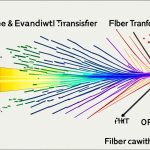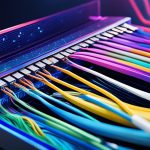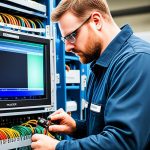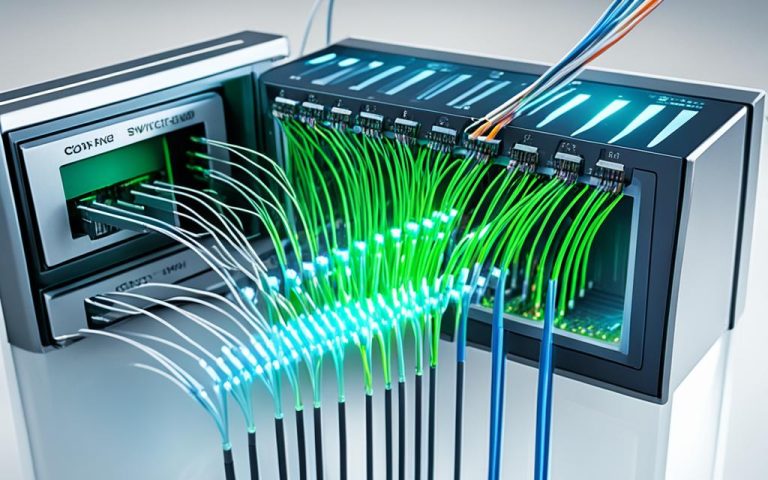Transforming Healthcare with Fiber Optics: Telemedicine and Beyond
Fiber optics has revolutionized telecommunications, but its impact extends far beyond that. In the field of healthcare, fiber optics is transforming the way medical technology is utilized, revolutionizing patient care and opening doors to innovative advancements.
One of the most significant applications of fiber optics in healthcare is telemedicine. With the help of fiber optic internet, healthcare professionals can conduct remote consultations and diagnostics, providing much-needed access to medical expertise, particularly in underserved areas.
But the potential of fiber optics goes beyond telemedicine. In diagnostic procedures, fiber optics enhances accuracy and precision, enabling detailed examinations and procedures in specialties such as endoscopy and ophthalmology. It also plays a crucial role in biomedical research, facilitating advanced imaging techniques and confocal microscopy.
The high-speed and low-latency communication offered by fiber optic internet supports data-intensive healthcare, allowing for quick transfer of large datasets and improving diagnosis and treatment planning. Furthermore, fiber optic internet enhances patient care by facilitating high-speed telehealth consultations and supporting the Internet of Medical Things (IoMT), where medical devices and applications are connected to the healthcare IT system.
Phonoscope Fiber is at the forefront of advancing fiber optic technology in healthcare, ensuring that healthcare providers can harness the full potential of this incredible innovation to revolutionize patient care.
Fiber Optics in Medical Procedures
Fiber optics has revolutionized the field of medical procedures, enabling advancements in various specialties and enhancing patient outcomes. This section explores the key applications of fiber optic technology in endoscopy, ophthalmology, and surgical precision.
Fiber Optics in Endoscopy
In endoscopy, fiber optics plays a crucial role in improving both the efficiency of procedures and the comfort of patients. By utilizing fiber optic cables, medical professionals can visualize internal organs with exceptional clarity and precision. The use of fiber optics in endoscopy allows for real-time imaging, accurate diagnosis, and targeted treatment, leading to improved patient care.
Fiber Optic Technology in Ophthalmology
In ophthalmology, fiber optic technology has found its way into diagnostic tools, transforming the way clinicians examine the delicate structures of the eye. Fiber optic-based retinal examination devices provide high-resolution images that enable detailed assessments of ocular health. This enhanced visualization aids in the early detection and management of various eye conditions, leading to better patient outcomes.
Surgical Precision with Fiber Optics
One of the most significant advancements brought about by fiber optics is its impact on surgical procedures. Fiber optic technology provides enhanced lighting and visualization in deep or inaccessible areas of the body, enabling surgeons to perform intricate procedures with greater precision. This has paved the way for the development of minimally invasive surgery, neurosurgery, and complex spinal operations, revolutionizing surgical outcomes and reducing patient recovery time.
Furthermore, fiber optic technology ensures minimal tissue damage during surgeries, reduces the risk of complications, and enhances patient safety. Surgeons can navigate complex anatomical structures more effectively, leading to improved surgical accuracy and overall patient satisfaction.
“Fiber optics has transformed medical procedures by providing enhanced visualization, precise diagnostics, and improved patient outcomes.”
| Fiber Optics in Medical Procedures | Benefits |
|---|---|
| Endoscopy | Improved visualization, accurate diagnosis, targeted treatment |
| Ophthalmology | Detailed assessment of ocular health, early detection of eye conditions |
| Surgical Precision | Enhanced lighting and visualization, reduced tissue damage, improved surgical accuracy |
Expanding Medical Frontiers with Fiber Optics
In the field of healthcare, fiber optics not only enhances diagnostic procedures and surgical techniques but also plays a pivotal role in biomedical research and telemedicine. By enabling advanced imaging techniques and providing remote consultations and diagnostics, fiber optics continues to transform and expand the frontiers of medicine.
Fiber Optics in Biomedical Research
The use of fiber optics has become a cornerstone in biomedical research, particularly in fields like oncology and neurobiology. One notable application is confocal microscopy, a technique that allows for high-resolution imaging of cells and tissues. By using a fine fiber optic probe to capture and transmit light, researchers can observe and analyze cellular structures with exceptional clarity and precision. This advanced imaging technique has greatly contributed to our understanding of disease mechanisms and the development of targeted treatments.
Fiber Optics in Telemedicine
Telemedicine, enabled by fiber optics, has revolutionized remote healthcare delivery, offering convenient and accessible services for patients in rural or underserved areas. Through telemedicine platforms, patients can consult with healthcare professionals, receive diagnoses, and access necessary treatments without the need for physical travel. Fiber optic technology ensures reliable and real-time transmission of medical data, enabling accurate remote diagnostics and providing timely medical interventions.
Furthermore, fiber optics has opened up new possibilities in telemedicine by even enabling remote surgeries. Surgeons can use fiber optic cables to transmit high-definition video and precise surgical instructions to a remote location, allowing them to perform complex procedures from a distance. This technological prowess has the potential to improve patient outcomes by providing specialized surgical expertise to regions without immediate access to specialized care.
The Critical Link of Fiber Optic Internet in Medicine
In today’s healthcare industry, the demand for data-intensive healthcare is growing rapidly. From patient records and diagnostic images to real-time monitoring, healthcare professionals rely on vast amounts of data to make critical decisions. This is where the power of high-speed fiber optic internet comes into play.
Fiber optic internet provides unparalleled bandwidth and speed, enabling healthcare providers to transfer large datasets quickly and securely. This has a significant impact on diagnosis and treatment planning, as healthcare professionals can access and analyze patient information with greater efficiency. With fiber optic internet, medical images can be transmitted and processed rapidly, allowing for faster and more accurate diagnoses.
But the benefits of fiber optic internet in healthcare go beyond data transfer. It revolutionizes patient care by enabling high-speed telehealth consultations. With fiber optic internet, patients and healthcare providers can connect seamlessly through video calls, ensuring timely and convenient access to medical expertise. This is particularly beneficial for patients in remote areas or with limited mobility, who can now receive quality healthcare without the need for travel.
Moreover, fiber optic internet plays a critical role in supporting the Internet of Medical Things (IoMT). The IoMT involves connecting various medical devices and applications to the healthcare IT system, allowing for real-time monitoring and intervention. With the high-speed and low-latency communication provided by fiber optic internet, patient data from wearables, sensors, and other medical devices can be transmitted swiftly, facilitating proactive and personalized care.
Powered by fiber optic internet, healthcare providers can harness the potential of data-intensive healthcare, ensuring quicker diagnoses, more efficient treatments, and improved patient outcomes. It is the critical link that enables the seamless flow of information and communication in the rapidly evolving landscape of modern medicine.

| Data-intensive Healthcare Benefits | High-Speed Internet in Healthcare | Fiber Optic Internet in Patient Care |
|---|---|---|
| Quicker diagnosis and treatment planning | Fast and reliable data transfer | Enhanced patient care through high-speed telehealth consultations |
| Improved access to medical expertise | Seamless communication between patients and healthcare providers | Supports the Internet of Medical Things (IoMT) for real-time monitoring |
| Enables proactive and personalized care | Efficient transmission of patient data from wearables and sensors | Facilitates timely intervention and enhanced disease management |
Enhancing Patient Care with Fiber Optic Internet
Fiber optic internet plays a crucial role in transforming and enhancing patient care, providing high-speed connectivity that unlocks a multitude of possibilities in telemedicine. By facilitating fast and reliable telehealth consultations, fiber optic internet enables healthcare professionals to deliver efficient care, particularly in emergency situations or for patients with limited mobility.
One of the key advantages of fiber optic internet in patient care is its ability to support real-time patient monitoring through wearable devices. These devices collect and transmit vital health data to healthcare providers, allowing for proactive disease management and personalized care. With fiber optic internet, remote patient monitoring becomes seamless, empowering healthcare teams to make informed decisions based on up-to-date information.
By leveraging the advantages of fiber optic internet, healthcare providers can improve health outcomes, enhance the quality of care, and increase patient satisfaction. The high-speed connectivity ensures that critical data reaches healthcare professionals promptly, enabling timely interventions and reducing potential risks. Patients can receive the care they need, regardless of their location, leading to better access to healthcare services.

The Benefits of High-Speed Connectivity in Patient Care
The integration of fiber optic internet with patient care brings several notable benefits:
- Enhanced Telehealth Consultations: Fiber optic internet enables high-quality video consultations, ensuring clear communication between healthcare professionals and patients. This improves the accuracy and effectiveness of remote diagnoses, resulting in optimized treatment plans.
- Improved Data Transfer: With fiber optic internet, the transmission of medical files and patient data becomes significantly faster, facilitating seamless collaboration between healthcare providers. This enhances care coordination, leading to streamlined workflows and improved patient outcomes.
- Real-Time Monitoring and Alerts: Fiber optic internet allows for the continuous flow of real-time data from wearable devices and remote monitoring systems. Healthcare professionals can promptly detect any abnormalities or fluctuations in vital signs, enabling early intervention and proactive management of diseases.
Case Study: Transforming Remote Patient Care
In a remote community located far from urban healthcare facilities, fiber optic internet has revolutionized patient care. The community’s residents, including seniors with chronic conditions and individuals with limited mobility, now have access to high-quality medical consultations without the need for travel.
“Thanks to fiber optic internet, our healthcare providers can remotely monitor our vitals and adjust our treatment plans when necessary. It has greatly improved our quality of life and saved us from the burden of traveling long distances for medical appointments.”
– Sharon Nelson, resident of the remote community
The Future of Patient Care with Fiber Optic Internet
As technology advances and healthcare becomes increasingly reliant on digital solutions, fiber optic internet will continue to play a vital role in transforming patient care. The integration of artificial intelligence and machine learning algorithms with fiber optic data will enable more accurate diagnoses and predictive healthcare analytics.
In addition, the Internet of Medical Things (IoMT) will further harness the power of fiber optic internet, connecting various medical devices and applications to create a comprehensive healthcare ecosystem. This interconnected network will enhance the monitoring and management of chronic conditions, preventive care, and early disease detection.
The future of healthcare lies in the seamless integration of fiber optic internet and advanced medical technologies, promising improved health outcomes, enhanced patient experiences, and a more efficient healthcare system overall.
Exploring the Basics of Fiber Optic Health Monitoring Systems
Fiber optic technology has revolutionized various industries, including healthcare. With its ability to transmit information using light through optical fibers, fiber optic technology has become an essential component of health monitoring systems. Let us delve into the fundamental aspects of fiber optic health monitoring and its crucial components for accurately measuring vital health parameters.
Fiber Optic Sensors: Monitoring Health Parameters with Accuracy
Fiber optic sensors are at the heart of health monitoring systems, providing precise measurements of vital health parameters. These sensors are specifically designed to detect and analyze various physiological indicators, including:
- Heart rate
- Blood pressure
- Temperature
- Oxygen saturation levels
- Glucometry
By utilizing the principles of fiber optic technology, these sensors can capture real-time data and transmit it to the monitoring systems. This enables healthcare professionals to have a comprehensive view of an individual’s health condition and make informed decisions regarding their care.
Data Analysis and Interpretation: Maximizing the Potential
Fiber optic health monitoring systems generate massive amounts of data. The true potential lies in the efficient analysis and interpretation of this data. Advanced algorithms and machine learning techniques play a vital role in extracting meaningful insights from the collected information.
“Accurate analysis and interpretation of the data obtained from fiber optic health monitoring systems provide invaluable insights into an individual’s health condition, aiding in early detection of diseases, personalized treatment plans, and overall improved healthcare outcomes.”
Data analysis allows healthcare professionals to identify trends, patterns, and anomalies in health parameters, enabling timely interventions and proactive management of chronic conditions. Moreover, the interpretation of the data facilitates personalized care plans based on an individual’s specific needs and requirements.
Fiber Optic Health Monitoring: A New Era in Healthcare
Fiber optic health monitoring systems, with their accurate measurement capabilities and advanced data analysis, have the potential to transform healthcare by:
- Enabling real-time monitoring of vital health parameters
- Facilitating early detection and intervention for diseases
- Supporting personalized treatment plans
- Improving overall healthcare outcomes
As technology continues to advance, fiber optic health monitoring systems will play a crucial role in ensuring timely and effective healthcare interventions, leading to improved patient care and enhanced quality of life.
| Fiber Optic Health Monitoring Advantages | Challenges |
|---|---|
| Real-time monitoring of health parameters | Integration with existing healthcare systems |
| Early detection of diseases | Data security and privacy concerns |
| Personalized treatment plans | Cost of implementation and maintenance |
| Improved healthcare outcomes | Interoperability and standardization |
The Role of Fiber Optic Sensors in Healthcare
Fiber optic sensors revolutionize healthcare by monitoring vital signs in real-time, empowering medical professionals to respond promptly to any fluctuations or abnormalities. These sensors provide accurate and reliable data essential for delivering high-quality patient care and enhance disease management. Fiber optic sensors also excel in environmental sensing, identifying external factors that influence overall well-being.
Real-time vital signs monitoring is crucial in healthcare, as it allows healthcare providers to closely monitor patients and detect any changes in their condition promptly. Fiber optic sensors offer several advantages in this regard. Firstly, these sensors provide high accuracy and precision, ensuring that the recorded data is reliable and trustworthy.
Unlike traditional sensors, fiber optic sensors are immune to electromagnetic interference and do not require direct electrical contact with the patient’s body. This non-invasive monitoring approach minimizes patient discomfort and reduces the risk of infection. The flexibility and lightweight nature of fiber optic sensors further enhance patient comfort, making them suitable for long-term monitoring.
Fiber optic sensors can monitor various vital signs, including heart rate, blood pressure, respiratory rate, and body temperature, providing a comprehensive view of a patient’s health status. The real-time data obtained from these sensors enables healthcare professionals to make informed decisions and take immediate action if necessary.
In addition to vital signs monitoring, fiber optic sensors are also utilized in environmental sensing in healthcare settings. These sensors detect and measure parameters such as temperature, humidity, air quality, and light intensity, contributing to a safe and optimized healthcare environment. By monitoring these environmental factors, healthcare providers can ensure optimal conditions for patient care and prevent potential risks.
Fiber optic sensors are essential in critical care units, operating rooms, and research laboratories, where continuous monitoring of vital signs and environmental conditions is paramount. These sensors enable quick detection of any deviations or potential hazards, facilitating timely interventions and ensuring patient safety.
Furthermore, the integration of fiber optic sensors with advanced data analysis and interpretation techniques allows for better understanding and prediction of health trends. By analyzing the collected data, healthcare professionals can identify patterns, detect early warning signs, and initiate preventive measures, leading to improved patient outcomes and disease management.
Overall, fiber optic sensors have revolutionized healthcare by providing real-time monitoring of vital signs and environmental factors. These sensors play a vital role in delivering high-quality patient care, enhancing disease management, and ensuring a safe healthcare environment. As technology continues to advance, further innovations in fiber optic sensing hold the potential to transform healthcare and improve the overall well-being of individuals.
Conclusion
Broadband connectivity is a vital component in the advancement of telemedicine and digital health solutions. It enables healthcare providers to offer high-quality video consultations, seamless transfer of medical files, and real-time exchange of patient data. With its impact on healthcare delivery, broadband technology has the potential to revolutionize the future of healthcare.
A leading broadband consultancy firm, SolveForce, plays a crucial role in helping healthcare providers navigate the complexities of broadband connectivity. By providing expert guidance and support, SolveForce ensures that healthcare organizations can leverage broadband to expand access to care, improve patient outcomes, and increase operational efficiency.
Enhanced broadband connectivity in healthcare not only fosters innovation but also enables transformative changes. It empowers healthcare professionals to deliver personalized care remotely, bridging the distance between patients and providers. As broadband technology continues to advance, we can anticipate further innovations in telemedicine and fiber optic-based devices, ushering in a new era of seamless and efficient healthcare delivery.
FAQ
How has fiber optics transformed healthcare?
Fiber optics has revolutionized healthcare by enhancing diagnostic procedures, enabling surgical techniques, expanding telemedicine, and aiding in biomedical research. Its impact can be seen in endoscopy, ophthalmology, surgical precision, advanced imaging techniques, and remote consultations and diagnostics.
What role does fiber optics play in endoscopy?
Fiber optics has transformed endoscopy by making it more efficient and comfortable for patients. It provides enhanced lighting and visualization in deep or inaccessible areas of the body, improving the accuracy and effectiveness of diagnostic procedures.
How does fiber optic technology benefit ophthalmology?
Fiber optic technology aids detailed retinal examinations in ophthalmology, allowing medical professionals to accurately diagnose and treat eye conditions. It enhances the clarity of images and provides valuable insights for patient care.
In what ways has fiber optics revolutionized surgical procedures?
Fiber optics has revolutionized surgical procedures by providing enhanced lighting and visualization in deep or inaccessible areas of the body. This advancement has been critical in developing minimally invasive surgery, neurosurgery, and intricate spinal operations, resulting in improved surgical outcomes.
How does fiber optics contribute to biomedical research?
Fiber optics is a cornerstone in biomedical research, enabling advanced imaging techniques such as confocal microscopy. These techniques are crucial in fields like oncology and neurobiology, allowing researchers to study cells and tissues in unprecedented detail.
How does fiber optics support telemedicine?
Fiber optics enables telemedicine by providing high-speed, low-latency communication. It allows for remote consultations and diagnostics, particularly beneficial in rural or underserved areas. Fiber optic technology even enables remote surgeries, expanding access to specialized care.
Why is fiber optic internet critical in healthcare?
Fiber optic internet supports data-intensive healthcare by facilitating the quick transfer of large datasets. It enables high-speed telehealth consultations, supports the Internet of Medical Things (IoMT), and enhances patient care by improving diagnosis, treatment planning, and real-time monitoring.
How does fiber optic internet enhance patient care?
Fiber optic internet facilitates high-speed telehealth consultations, particularly beneficial in emergency situations or for patients with mobility issues. It also supports patient monitoring through wearable devices, enabling real-time data transmission to healthcare providers for proactive disease management and personalized care.
What are fiber optic health monitoring systems?
Fiber optic health monitoring systems involve transmitting health information using light through optical fibers. These systems utilize specialized sensors to measure vital health parameters accurately. Data analysis and interpretation play a crucial role in maximizing the potential of these systems, providing meaningful insights into an individual’s health condition.
How do fiber optic sensors revolutionize healthcare?
Fiber optic sensors revolutionize healthcare by monitoring vital signs in real-time. They empower medical professionals to respond promptly to any fluctuations or abnormalities, allowing for high-quality patient care and better disease management. Fiber optic sensors also excel in environmental sensing, identifying external factors that influence overall well-being for improved health outcomes.
How does broadband connectivity impact telemedicine and healthcare?
Broadband connectivity plays a critical role in telemedicine and other digital health solutions. It enables high-quality video consultations, the transfer of medical files, and real-time exchange of patient data. Enhanced broadband connectivity expands access to care, improves patient outcomes, increases operational efficiency, and fosters innovation in healthcare delivery.
How does SolveForce help healthcare providers with broadband connectivity?
SolveForce, a leading broadband consultancy firm, helps healthcare providers navigate the complexities of broadband connectivity. They provide expertise and guidance in optimizing broadband solutions to meet the specific needs of healthcare organizations, ensuring reliable and efficient connectivity.
What does the future hold for fiber optics in healthcare?
As broadband technology continues to advance, further innovations in telemedicine and fiber optic-based devices are expected. Fiber optics will continue to revolutionize healthcare delivery, improving access to care, enhancing patient outcomes, and driving advancements in medical technology.



















